Ottawa Charter & Health Promotion: Nurse's Role in 5 Key Strategies
VerifiedAdded on 2023/06/13
|8
|2094
|105
Essay
AI Summary
This essay explores the critical role of nurses in health promotion, focusing on the five major strategies outlined in the Ottawa Charter for Health Promotion. It addresses the rising concern of obesity and how these strategies can be instrumental in curbing its rise and promoting better health. The essay discusses building healthy public policies, creating supportive environments, strengthening community action, developing personal skills, and reorienting health services. It emphasizes the importance of nurses in advocating for policy changes, educating the public, and implementing preventive measures to manage and prevent obesity, ultimately promoting public health and well-being. The document is available on Desklib, a platform offering a range of study tools and resources for students.
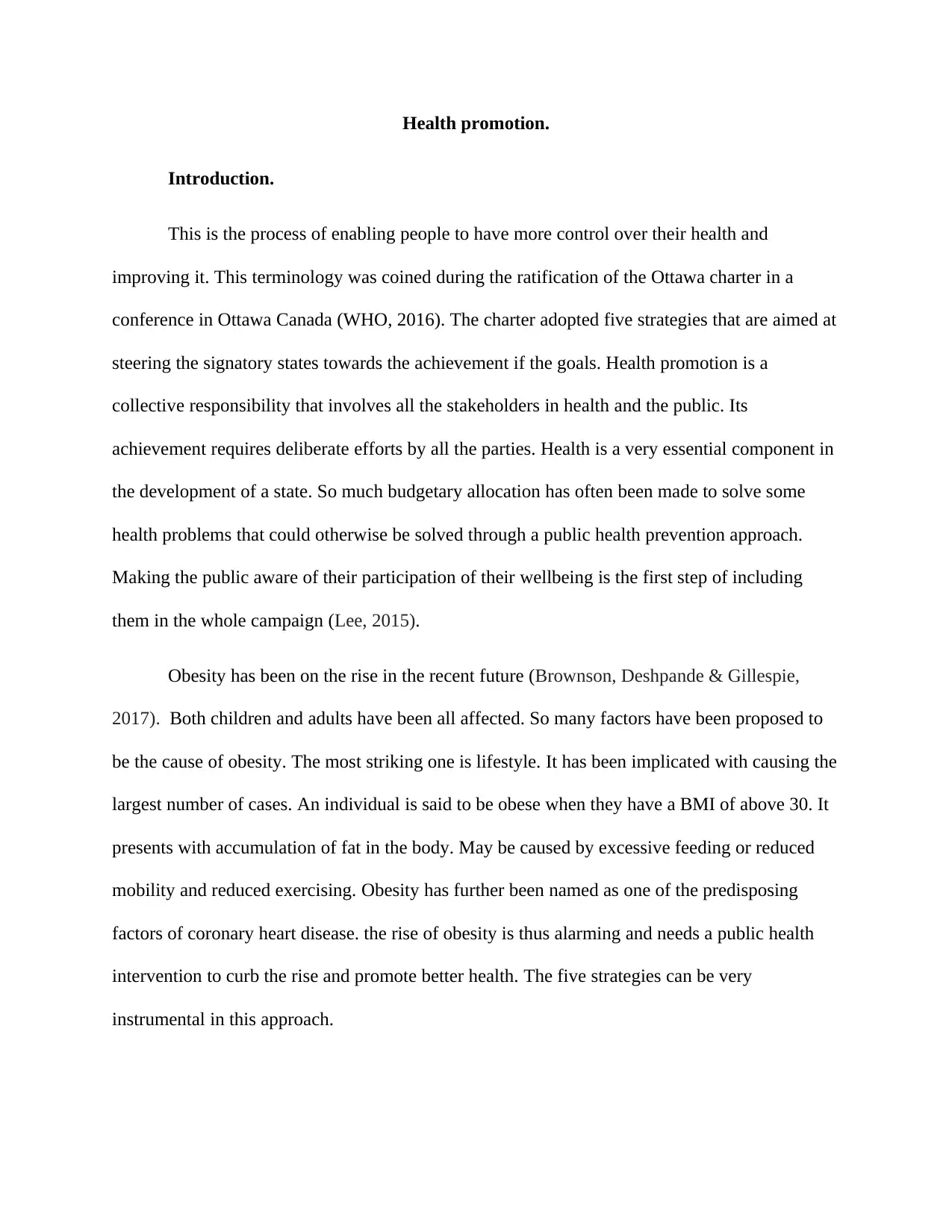
Health promotion.
Introduction.
This is the process of enabling people to have more control over their health and
improving it. This terminology was coined during the ratification of the Ottawa charter in a
conference in Ottawa Canada (WHO, 2016). The charter adopted five strategies that are aimed at
steering the signatory states towards the achievement if the goals. Health promotion is a
collective responsibility that involves all the stakeholders in health and the public. Its
achievement requires deliberate efforts by all the parties. Health is a very essential component in
the development of a state. So much budgetary allocation has often been made to solve some
health problems that could otherwise be solved through a public health prevention approach.
Making the public aware of their participation of their wellbeing is the first step of including
them in the whole campaign (Lee, 2015).
Obesity has been on the rise in the recent future (Brownson, Deshpande & Gillespie,
2017). Both children and adults have been all affected. So many factors have been proposed to
be the cause of obesity. The most striking one is lifestyle. It has been implicated with causing the
largest number of cases. An individual is said to be obese when they have a BMI of above 30. It
presents with accumulation of fat in the body. May be caused by excessive feeding or reduced
mobility and reduced exercising. Obesity has further been named as one of the predisposing
factors of coronary heart disease. the rise of obesity is thus alarming and needs a public health
intervention to curb the rise and promote better health. The five strategies can be very
instrumental in this approach.
Introduction.
This is the process of enabling people to have more control over their health and
improving it. This terminology was coined during the ratification of the Ottawa charter in a
conference in Ottawa Canada (WHO, 2016). The charter adopted five strategies that are aimed at
steering the signatory states towards the achievement if the goals. Health promotion is a
collective responsibility that involves all the stakeholders in health and the public. Its
achievement requires deliberate efforts by all the parties. Health is a very essential component in
the development of a state. So much budgetary allocation has often been made to solve some
health problems that could otherwise be solved through a public health prevention approach.
Making the public aware of their participation of their wellbeing is the first step of including
them in the whole campaign (Lee, 2015).
Obesity has been on the rise in the recent future (Brownson, Deshpande & Gillespie,
2017). Both children and adults have been all affected. So many factors have been proposed to
be the cause of obesity. The most striking one is lifestyle. It has been implicated with causing the
largest number of cases. An individual is said to be obese when they have a BMI of above 30. It
presents with accumulation of fat in the body. May be caused by excessive feeding or reduced
mobility and reduced exercising. Obesity has further been named as one of the predisposing
factors of coronary heart disease. the rise of obesity is thus alarming and needs a public health
intervention to curb the rise and promote better health. The five strategies can be very
instrumental in this approach.
Paraphrase This Document
Need a fresh take? Get an instant paraphrase of this document with our AI Paraphraser
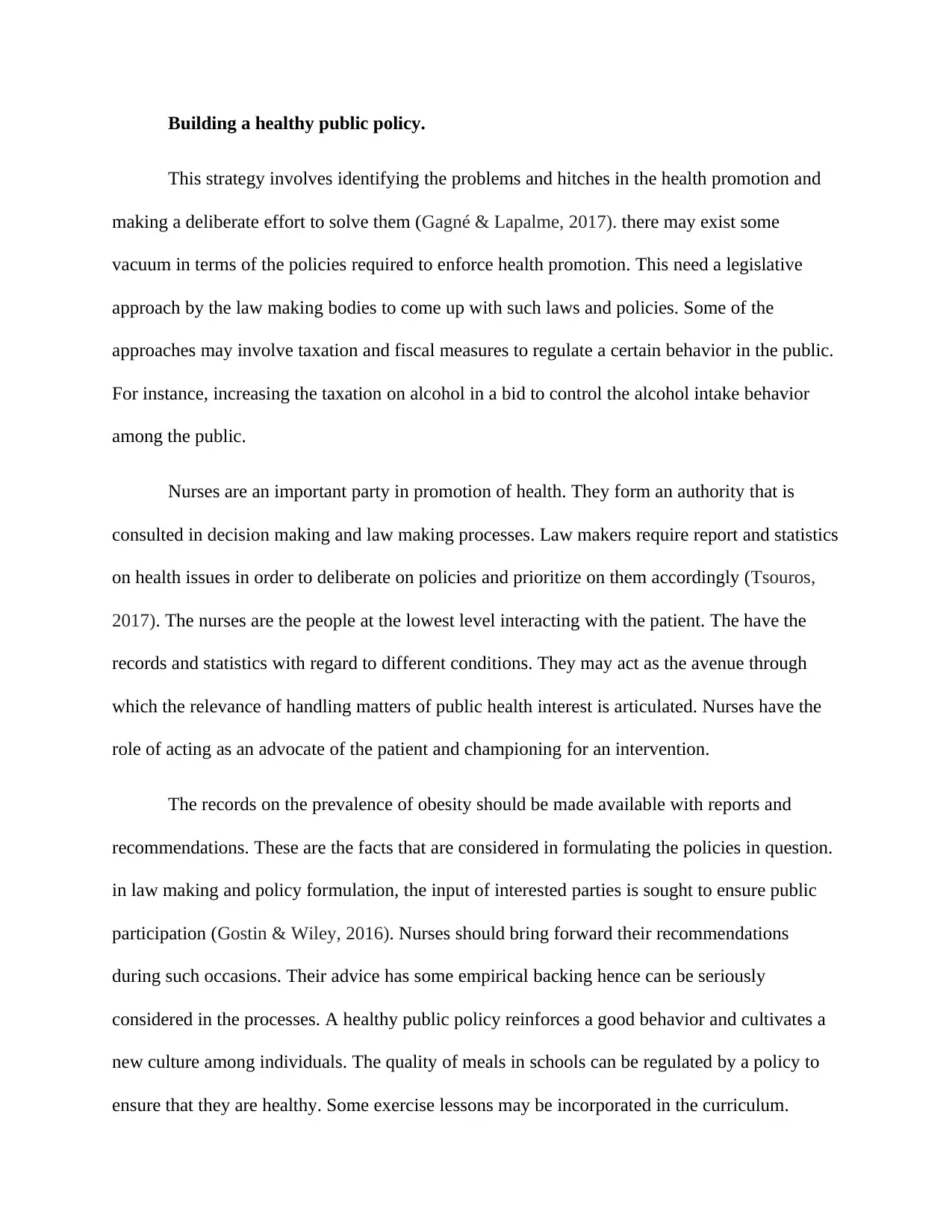
Building a healthy public policy.
This strategy involves identifying the problems and hitches in the health promotion and
making a deliberate effort to solve them (Gagné & Lapalme, 2017). there may exist some
vacuum in terms of the policies required to enforce health promotion. This need a legislative
approach by the law making bodies to come up with such laws and policies. Some of the
approaches may involve taxation and fiscal measures to regulate a certain behavior in the public.
For instance, increasing the taxation on alcohol in a bid to control the alcohol intake behavior
among the public.
Nurses are an important party in promotion of health. They form an authority that is
consulted in decision making and law making processes. Law makers require report and statistics
on health issues in order to deliberate on policies and prioritize on them accordingly (Tsouros,
2017). The nurses are the people at the lowest level interacting with the patient. The have the
records and statistics with regard to different conditions. They may act as the avenue through
which the relevance of handling matters of public health interest is articulated. Nurses have the
role of acting as an advocate of the patient and championing for an intervention.
The records on the prevalence of obesity should be made available with reports and
recommendations. These are the facts that are considered in formulating the policies in question.
in law making and policy formulation, the input of interested parties is sought to ensure public
participation (Gostin & Wiley, 2016). Nurses should bring forward their recommendations
during such occasions. Their advice has some empirical backing hence can be seriously
considered in the processes. A healthy public policy reinforces a good behavior and cultivates a
new culture among individuals. The quality of meals in schools can be regulated by a policy to
ensure that they are healthy. Some exercise lessons may be incorporated in the curriculum.
This strategy involves identifying the problems and hitches in the health promotion and
making a deliberate effort to solve them (Gagné & Lapalme, 2017). there may exist some
vacuum in terms of the policies required to enforce health promotion. This need a legislative
approach by the law making bodies to come up with such laws and policies. Some of the
approaches may involve taxation and fiscal measures to regulate a certain behavior in the public.
For instance, increasing the taxation on alcohol in a bid to control the alcohol intake behavior
among the public.
Nurses are an important party in promotion of health. They form an authority that is
consulted in decision making and law making processes. Law makers require report and statistics
on health issues in order to deliberate on policies and prioritize on them accordingly (Tsouros,
2017). The nurses are the people at the lowest level interacting with the patient. The have the
records and statistics with regard to different conditions. They may act as the avenue through
which the relevance of handling matters of public health interest is articulated. Nurses have the
role of acting as an advocate of the patient and championing for an intervention.
The records on the prevalence of obesity should be made available with reports and
recommendations. These are the facts that are considered in formulating the policies in question.
in law making and policy formulation, the input of interested parties is sought to ensure public
participation (Gostin & Wiley, 2016). Nurses should bring forward their recommendations
during such occasions. Their advice has some empirical backing hence can be seriously
considered in the processes. A healthy public policy reinforces a good behavior and cultivates a
new culture among individuals. The quality of meals in schools can be regulated by a policy to
ensure that they are healthy. Some exercise lessons may be incorporated in the curriculum.
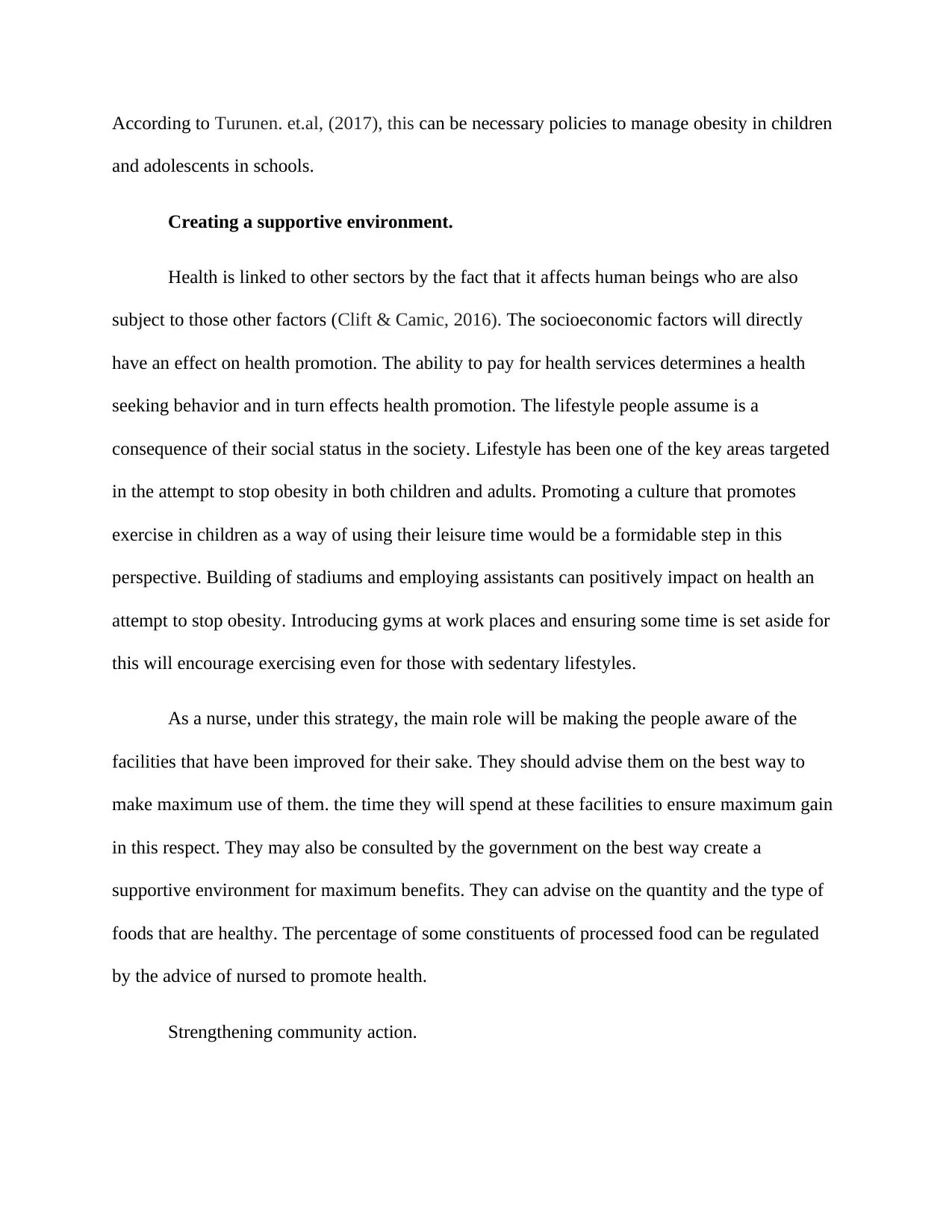
According to Turunen. et.al, (2017), this can be necessary policies to manage obesity in children
and adolescents in schools.
Creating a supportive environment.
Health is linked to other sectors by the fact that it affects human beings who are also
subject to those other factors (Clift & Camic, 2016). The socioeconomic factors will directly
have an effect on health promotion. The ability to pay for health services determines a health
seeking behavior and in turn effects health promotion. The lifestyle people assume is a
consequence of their social status in the society. Lifestyle has been one of the key areas targeted
in the attempt to stop obesity in both children and adults. Promoting a culture that promotes
exercise in children as a way of using their leisure time would be a formidable step in this
perspective. Building of stadiums and employing assistants can positively impact on health an
attempt to stop obesity. Introducing gyms at work places and ensuring some time is set aside for
this will encourage exercising even for those with sedentary lifestyles.
As a nurse, under this strategy, the main role will be making the people aware of the
facilities that have been improved for their sake. They should advise them on the best way to
make maximum use of them. the time they will spend at these facilities to ensure maximum gain
in this respect. They may also be consulted by the government on the best way create a
supportive environment for maximum benefits. They can advise on the quantity and the type of
foods that are healthy. The percentage of some constituents of processed food can be regulated
by the advice of nursed to promote health.
Strengthening community action.
and adolescents in schools.
Creating a supportive environment.
Health is linked to other sectors by the fact that it affects human beings who are also
subject to those other factors (Clift & Camic, 2016). The socioeconomic factors will directly
have an effect on health promotion. The ability to pay for health services determines a health
seeking behavior and in turn effects health promotion. The lifestyle people assume is a
consequence of their social status in the society. Lifestyle has been one of the key areas targeted
in the attempt to stop obesity in both children and adults. Promoting a culture that promotes
exercise in children as a way of using their leisure time would be a formidable step in this
perspective. Building of stadiums and employing assistants can positively impact on health an
attempt to stop obesity. Introducing gyms at work places and ensuring some time is set aside for
this will encourage exercising even for those with sedentary lifestyles.
As a nurse, under this strategy, the main role will be making the people aware of the
facilities that have been improved for their sake. They should advise them on the best way to
make maximum use of them. the time they will spend at these facilities to ensure maximum gain
in this respect. They may also be consulted by the government on the best way create a
supportive environment for maximum benefits. They can advise on the quantity and the type of
foods that are healthy. The percentage of some constituents of processed food can be regulated
by the advice of nursed to promote health.
Strengthening community action.
⊘ This is a preview!⊘
Do you want full access?
Subscribe today to unlock all pages.

Trusted by 1+ million students worldwide
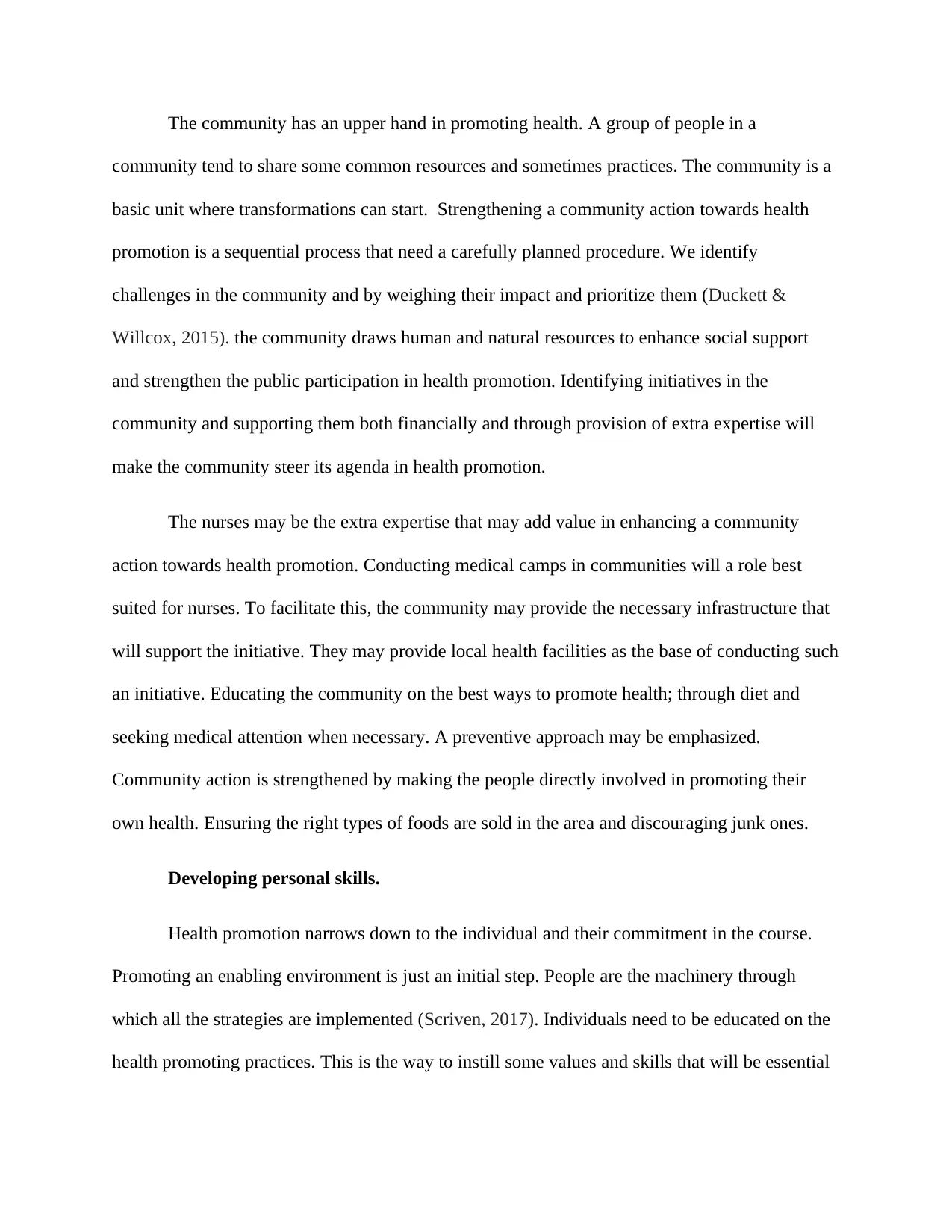
The community has an upper hand in promoting health. A group of people in a
community tend to share some common resources and sometimes practices. The community is a
basic unit where transformations can start. Strengthening a community action towards health
promotion is a sequential process that need a carefully planned procedure. We identify
challenges in the community and by weighing their impact and prioritize them (Duckett &
Willcox, 2015). the community draws human and natural resources to enhance social support
and strengthen the public participation in health promotion. Identifying initiatives in the
community and supporting them both financially and through provision of extra expertise will
make the community steer its agenda in health promotion.
The nurses may be the extra expertise that may add value in enhancing a community
action towards health promotion. Conducting medical camps in communities will a role best
suited for nurses. To facilitate this, the community may provide the necessary infrastructure that
will support the initiative. They may provide local health facilities as the base of conducting such
an initiative. Educating the community on the best ways to promote health; through diet and
seeking medical attention when necessary. A preventive approach may be emphasized.
Community action is strengthened by making the people directly involved in promoting their
own health. Ensuring the right types of foods are sold in the area and discouraging junk ones.
Developing personal skills.
Health promotion narrows down to the individual and their commitment in the course.
Promoting an enabling environment is just an initial step. People are the machinery through
which all the strategies are implemented (Scriven, 2017). Individuals need to be educated on the
health promoting practices. This is the way to instill some values and skills that will be essential
community tend to share some common resources and sometimes practices. The community is a
basic unit where transformations can start. Strengthening a community action towards health
promotion is a sequential process that need a carefully planned procedure. We identify
challenges in the community and by weighing their impact and prioritize them (Duckett &
Willcox, 2015). the community draws human and natural resources to enhance social support
and strengthen the public participation in health promotion. Identifying initiatives in the
community and supporting them both financially and through provision of extra expertise will
make the community steer its agenda in health promotion.
The nurses may be the extra expertise that may add value in enhancing a community
action towards health promotion. Conducting medical camps in communities will a role best
suited for nurses. To facilitate this, the community may provide the necessary infrastructure that
will support the initiative. They may provide local health facilities as the base of conducting such
an initiative. Educating the community on the best ways to promote health; through diet and
seeking medical attention when necessary. A preventive approach may be emphasized.
Community action is strengthened by making the people directly involved in promoting their
own health. Ensuring the right types of foods are sold in the area and discouraging junk ones.
Developing personal skills.
Health promotion narrows down to the individual and their commitment in the course.
Promoting an enabling environment is just an initial step. People are the machinery through
which all the strategies are implemented (Scriven, 2017). Individuals need to be educated on the
health promoting practices. This is the way to instill some values and skills that will be essential
Paraphrase This Document
Need a fresh take? Get an instant paraphrase of this document with our AI Paraphraser
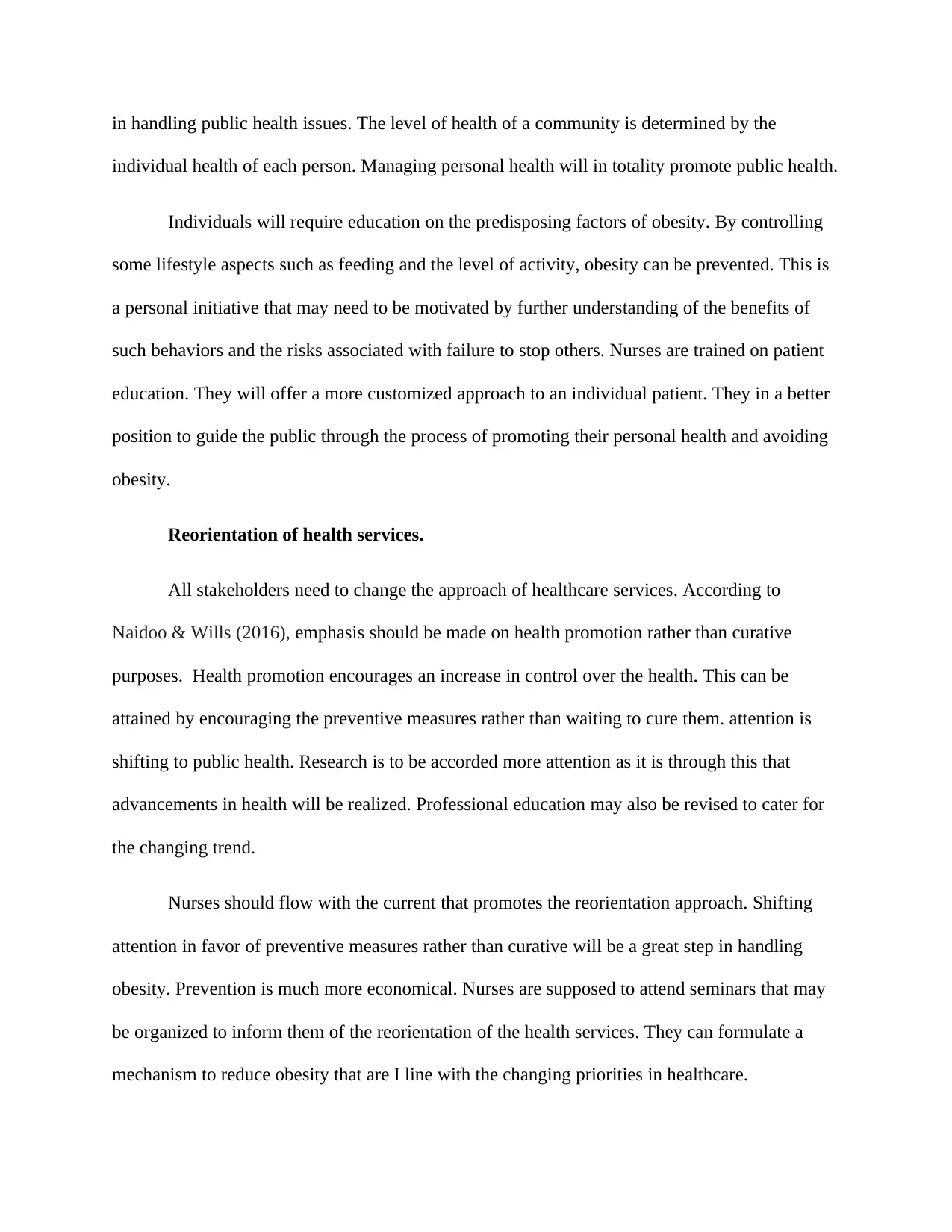
in handling public health issues. The level of health of a community is determined by the
individual health of each person. Managing personal health will in totality promote public health.
Individuals will require education on the predisposing factors of obesity. By controlling
some lifestyle aspects such as feeding and the level of activity, obesity can be prevented. This is
a personal initiative that may need to be motivated by further understanding of the benefits of
such behaviors and the risks associated with failure to stop others. Nurses are trained on patient
education. They will offer a more customized approach to an individual patient. They in a better
position to guide the public through the process of promoting their personal health and avoiding
obesity.
Reorientation of health services.
All stakeholders need to change the approach of healthcare services. According to
Naidoo & Wills (2016), emphasis should be made on health promotion rather than curative
purposes. Health promotion encourages an increase in control over the health. This can be
attained by encouraging the preventive measures rather than waiting to cure them. attention is
shifting to public health. Research is to be accorded more attention as it is through this that
advancements in health will be realized. Professional education may also be revised to cater for
the changing trend.
Nurses should flow with the current that promotes the reorientation approach. Shifting
attention in favor of preventive measures rather than curative will be a great step in handling
obesity. Prevention is much more economical. Nurses are supposed to attend seminars that may
be organized to inform them of the reorientation of the health services. They can formulate a
mechanism to reduce obesity that are I line with the changing priorities in healthcare.
individual health of each person. Managing personal health will in totality promote public health.
Individuals will require education on the predisposing factors of obesity. By controlling
some lifestyle aspects such as feeding and the level of activity, obesity can be prevented. This is
a personal initiative that may need to be motivated by further understanding of the benefits of
such behaviors and the risks associated with failure to stop others. Nurses are trained on patient
education. They will offer a more customized approach to an individual patient. They in a better
position to guide the public through the process of promoting their personal health and avoiding
obesity.
Reorientation of health services.
All stakeholders need to change the approach of healthcare services. According to
Naidoo & Wills (2016), emphasis should be made on health promotion rather than curative
purposes. Health promotion encourages an increase in control over the health. This can be
attained by encouraging the preventive measures rather than waiting to cure them. attention is
shifting to public health. Research is to be accorded more attention as it is through this that
advancements in health will be realized. Professional education may also be revised to cater for
the changing trend.
Nurses should flow with the current that promotes the reorientation approach. Shifting
attention in favor of preventive measures rather than curative will be a great step in handling
obesity. Prevention is much more economical. Nurses are supposed to attend seminars that may
be organized to inform them of the reorientation of the health services. They can formulate a
mechanism to reduce obesity that are I line with the changing priorities in healthcare.
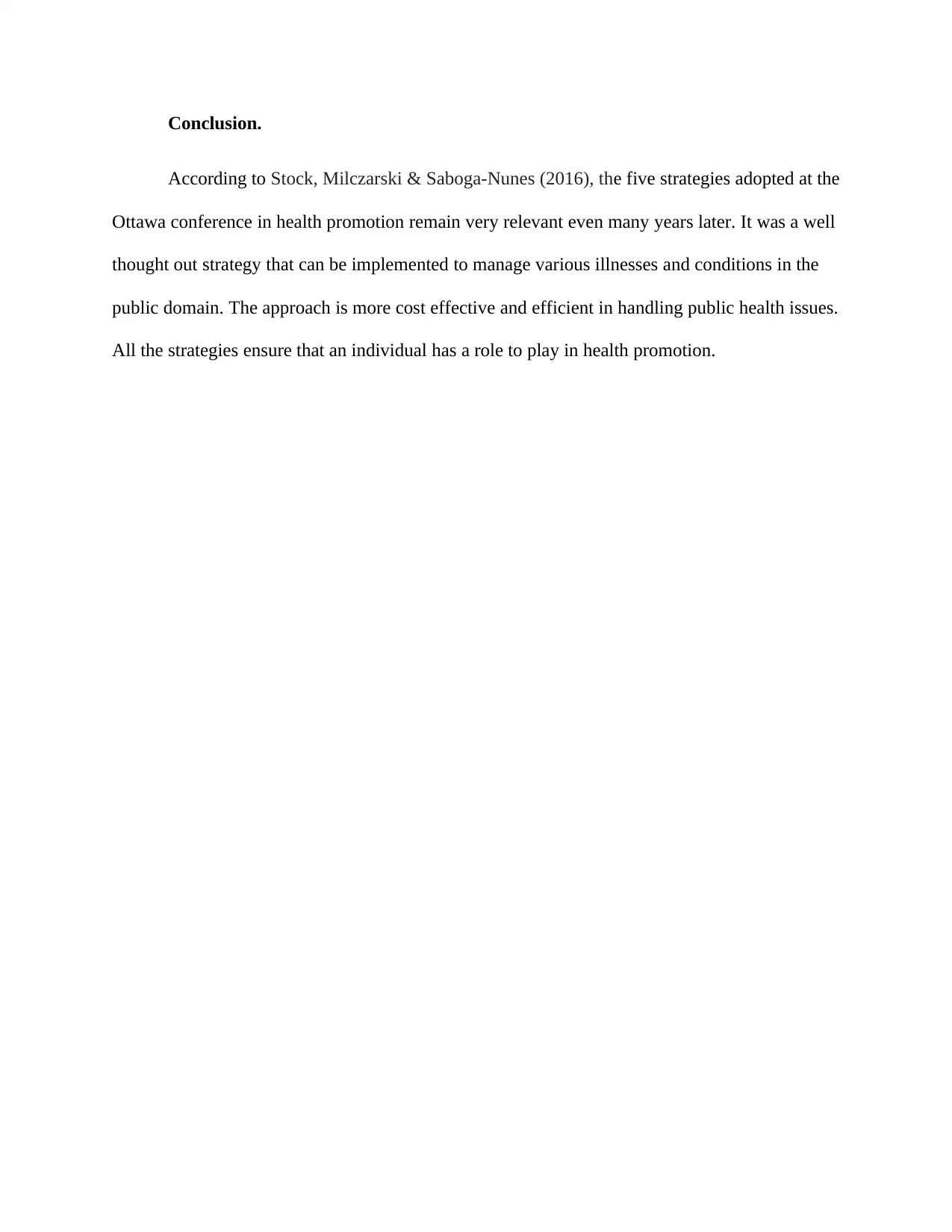
Conclusion.
According to Stock, Milczarski & Saboga-Nunes (2016), the five strategies adopted at the
Ottawa conference in health promotion remain very relevant even many years later. It was a well
thought out strategy that can be implemented to manage various illnesses and conditions in the
public domain. The approach is more cost effective and efficient in handling public health issues.
All the strategies ensure that an individual has a role to play in health promotion.
According to Stock, Milczarski & Saboga-Nunes (2016), the five strategies adopted at the
Ottawa conference in health promotion remain very relevant even many years later. It was a well
thought out strategy that can be implemented to manage various illnesses and conditions in the
public domain. The approach is more cost effective and efficient in handling public health issues.
All the strategies ensure that an individual has a role to play in health promotion.
⊘ This is a preview!⊘
Do you want full access?
Subscribe today to unlock all pages.

Trusted by 1+ million students worldwide
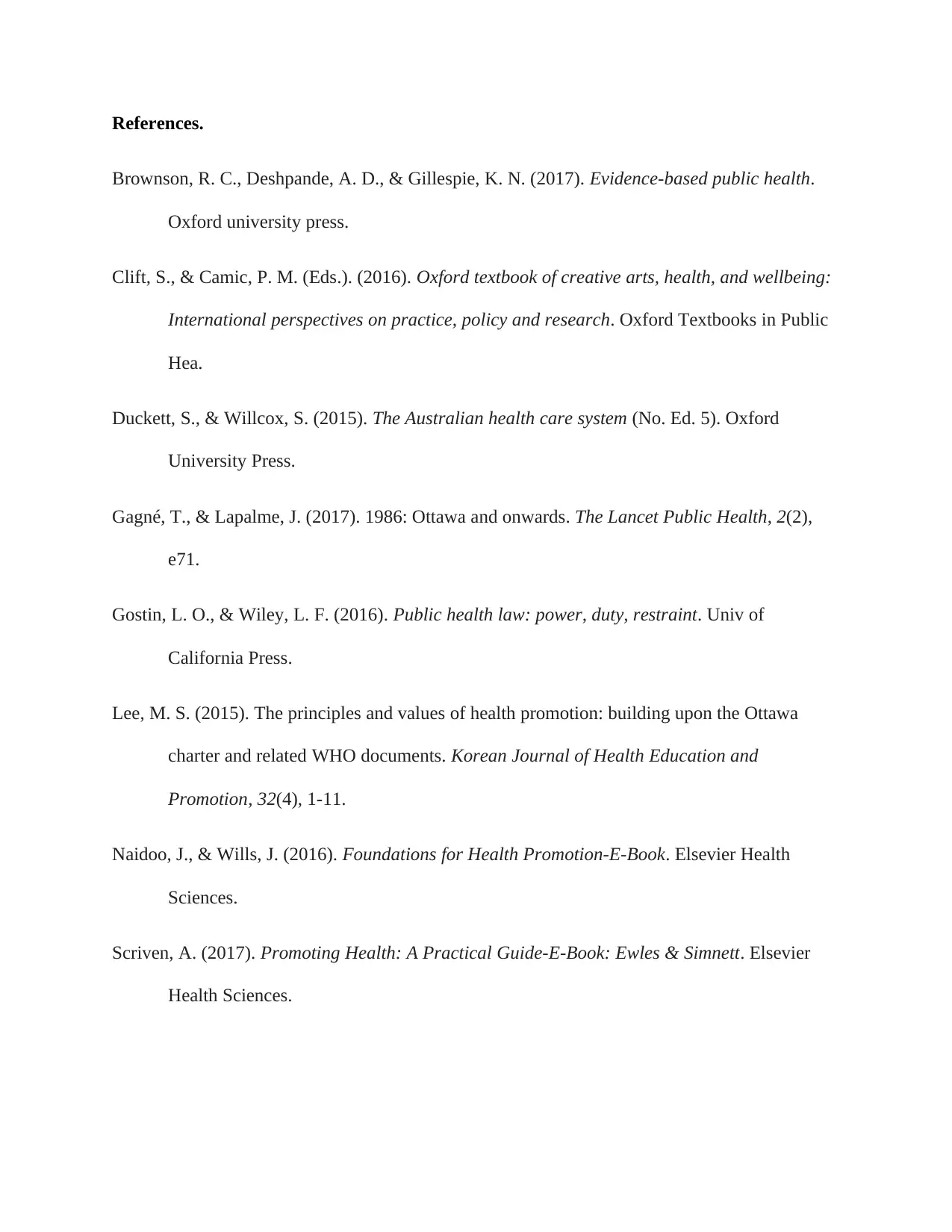
References.
Brownson, R. C., Deshpande, A. D., & Gillespie, K. N. (2017). Evidence-based public health.
Oxford university press.
Clift, S., & Camic, P. M. (Eds.). (2016). Oxford textbook of creative arts, health, and wellbeing:
International perspectives on practice, policy and research. Oxford Textbooks in Public
Hea.
Duckett, S., & Willcox, S. (2015). The Australian health care system (No. Ed. 5). Oxford
University Press.
Gagné, T., & Lapalme, J. (2017). 1986: Ottawa and onwards. The Lancet Public Health, 2(2),
e71.
Gostin, L. O., & Wiley, L. F. (2016). Public health law: power, duty, restraint. Univ of
California Press.
Lee, M. S. (2015). The principles and values of health promotion: building upon the Ottawa
charter and related WHO documents. Korean Journal of Health Education and
Promotion, 32(4), 1-11.
Naidoo, J., & Wills, J. (2016). Foundations for Health Promotion-E-Book. Elsevier Health
Sciences.
Scriven, A. (2017). Promoting Health: A Practical Guide-E-Book: Ewles & Simnett. Elsevier
Health Sciences.
Brownson, R. C., Deshpande, A. D., & Gillespie, K. N. (2017). Evidence-based public health.
Oxford university press.
Clift, S., & Camic, P. M. (Eds.). (2016). Oxford textbook of creative arts, health, and wellbeing:
International perspectives on practice, policy and research. Oxford Textbooks in Public
Hea.
Duckett, S., & Willcox, S. (2015). The Australian health care system (No. Ed. 5). Oxford
University Press.
Gagné, T., & Lapalme, J. (2017). 1986: Ottawa and onwards. The Lancet Public Health, 2(2),
e71.
Gostin, L. O., & Wiley, L. F. (2016). Public health law: power, duty, restraint. Univ of
California Press.
Lee, M. S. (2015). The principles and values of health promotion: building upon the Ottawa
charter and related WHO documents. Korean Journal of Health Education and
Promotion, 32(4), 1-11.
Naidoo, J., & Wills, J. (2016). Foundations for Health Promotion-E-Book. Elsevier Health
Sciences.
Scriven, A. (2017). Promoting Health: A Practical Guide-E-Book: Ewles & Simnett. Elsevier
Health Sciences.
Paraphrase This Document
Need a fresh take? Get an instant paraphrase of this document with our AI Paraphraser
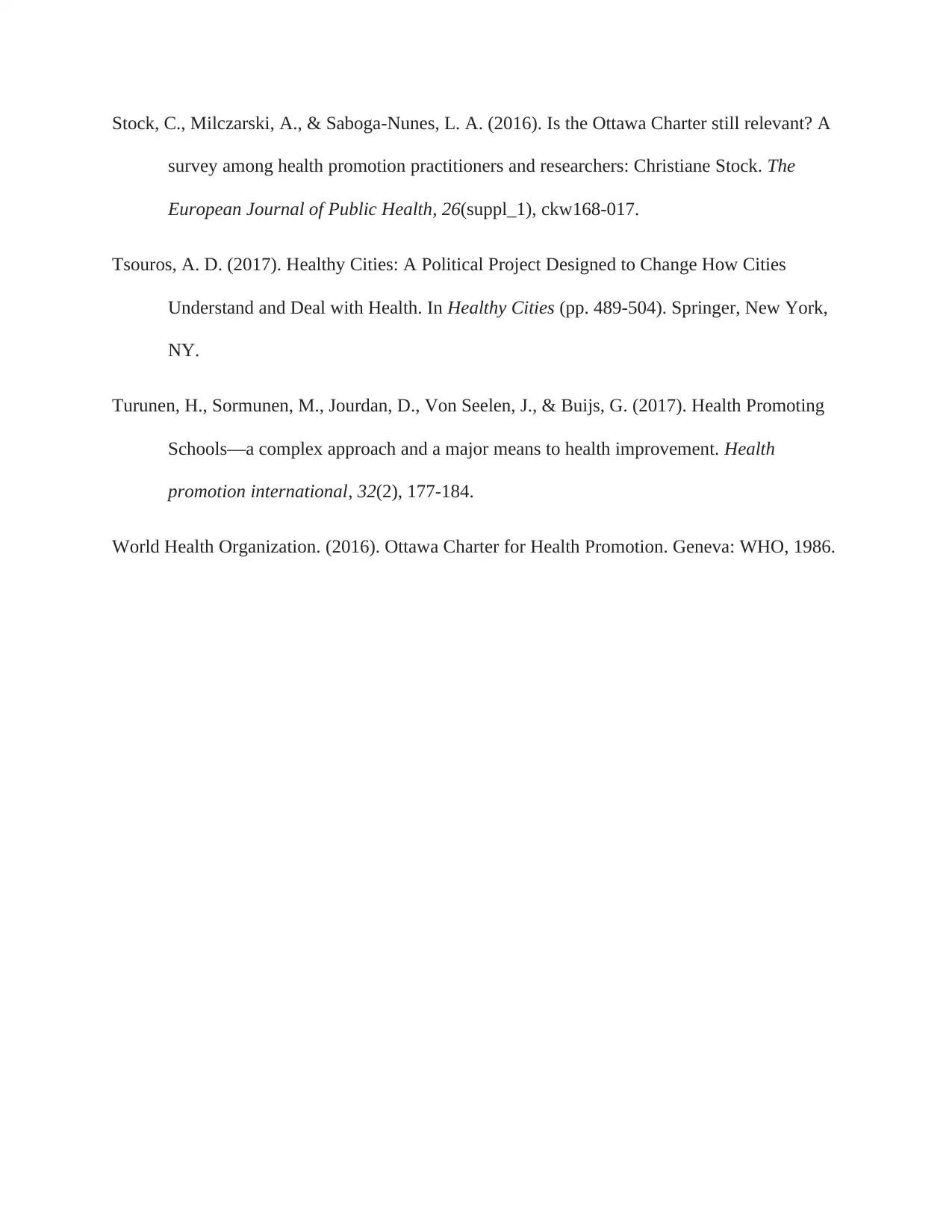
Stock, C., Milczarski, A., & Saboga-Nunes, L. A. (2016). Is the Ottawa Charter still relevant? A
survey among health promotion practitioners and researchers: Christiane Stock. The
European Journal of Public Health, 26(suppl_1), ckw168-017.
Tsouros, A. D. (2017). Healthy Cities: A Political Project Designed to Change How Cities
Understand and Deal with Health. In Healthy Cities (pp. 489-504). Springer, New York,
NY.
Turunen, H., Sormunen, M., Jourdan, D., Von Seelen, J., & Buijs, G. (2017). Health Promoting
Schools—a complex approach and a major means to health improvement. Health
promotion international, 32(2), 177-184.
World Health Organization. (2016). Ottawa Charter for Health Promotion. Geneva: WHO, 1986.
survey among health promotion practitioners and researchers: Christiane Stock. The
European Journal of Public Health, 26(suppl_1), ckw168-017.
Tsouros, A. D. (2017). Healthy Cities: A Political Project Designed to Change How Cities
Understand and Deal with Health. In Healthy Cities (pp. 489-504). Springer, New York,
NY.
Turunen, H., Sormunen, M., Jourdan, D., Von Seelen, J., & Buijs, G. (2017). Health Promoting
Schools—a complex approach and a major means to health improvement. Health
promotion international, 32(2), 177-184.
World Health Organization. (2016). Ottawa Charter for Health Promotion. Geneva: WHO, 1986.
1 out of 8
Related Documents
Your All-in-One AI-Powered Toolkit for Academic Success.
+13062052269
info@desklib.com
Available 24*7 on WhatsApp / Email
![[object Object]](/_next/static/media/star-bottom.7253800d.svg)
Unlock your academic potential
Copyright © 2020–2025 A2Z Services. All Rights Reserved. Developed and managed by ZUCOL.





